Review: EuroCity Train “Croatia” Zagreb to Vienna
This review details a ride on the EuroCity train “Croatia” between Zagreb and Vienna in Austria.
Zagreb to Vienna by train
After a great stay at the lovely Esplanade Hotel in Zagreb it was time to move onward by train to Vienna.
The capitals of Croatia and Austria are connected by one daily EuroCity (EC) train in each direction, with train number EC 158 being the Zagreb to Vienna service and EC 159 being the Vienna to Zagreb service.
This EuroCity train service has the name “Croatia” and is a comfortable and scenic way to travel between the two capital cities.
After its departure in Zagreb the EuroCity train “Croatia” also stops in Maribor in Slovenia and the city of Graz in Austria among others before traversing the highly scenic Semmering Railway Line towards Vienna, where it terminates at the main station of Wien Hbf.
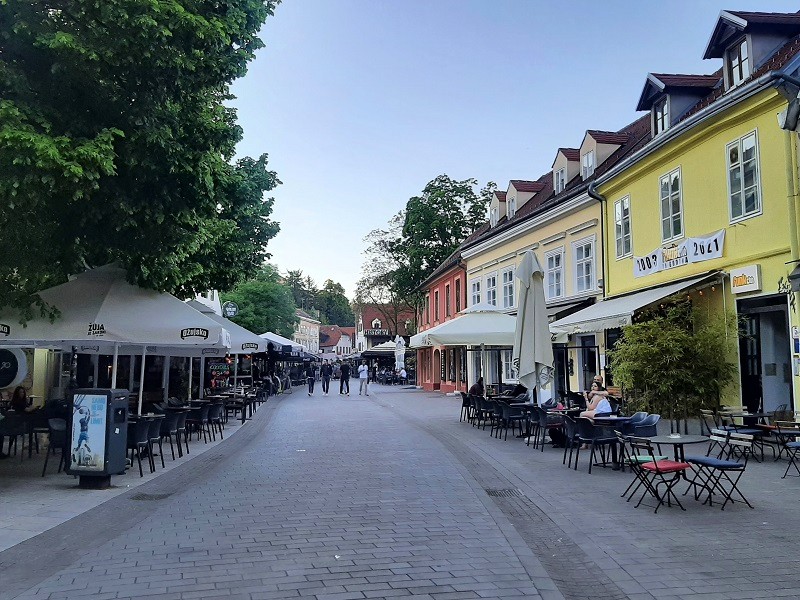
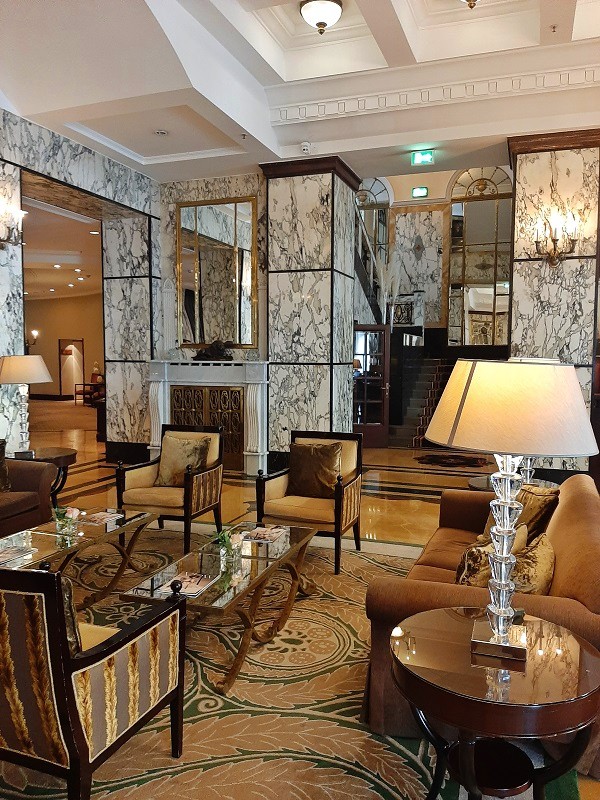
Buying your ticket
Second class train tickets between Zagreb and Vienna start at 29.90 euro if you manage to book a saver ticket.
These advanced tickets become progressively more expensive once the cheapest fare buckets sell out.
However, tickets for the “Croatia” EuroCity train cannot truly sell out and you can always get a full price second class ticket for €81.90 even on the day of travel.
Do note that advance saver fares are valid on your selected train departure only and cannot be refunded, although the full price tickets are fully flexible in regard to which exact train you take on the route and can be refunded up to one day before departure.
First class train fares between Zagreb and Vienna start at 39.90 euro for a saver ticket and go all the way up to €135.70 for a full price ticket
Seat reservation is optional on the Croatia EuroCity train and costs an extra €3, although this is highly advisable when travelling on or around important holidays or in the peak summer season.
You can buy your train ticket at any Croatian, Slovenian or Austrian railway station or online at the website of the Austrian Railways (OeBB), in which case you will be issued a PDF e-ticket.
EuroCity Train “Croatia” Zagreb to Split
Train EC158 – Departure: 7.25am – Arrival: 2.32pm
Duration: 7h07m – Distance: 448 kilometres
Second class, Wagon 409, Seat 106 – Costs: 29.90 EUR
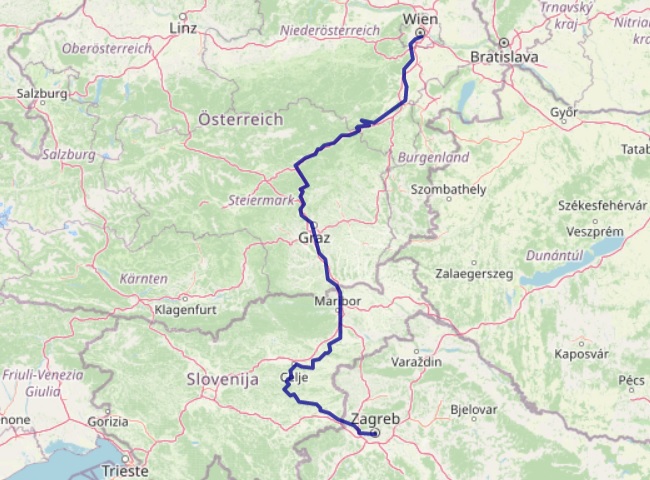
Zagreb station
It was a rainy spring morning when I headed to Zagreb’s imposing railway station to catch my train to Vienna.
I was booked on EuroCity train EC 158 which would depart Zagreb at 7.25am and arrive in Vienna at 2.32pm.
Zagreb’s train station is called Glavni Kolodvor, which simply means main station in Croatian.
The station is centrally located in the centre of Zagreb and an easy walk away from most of the city’s sights.
In the main station hall you can find several bakeries and small kiosks selling snacks and drinks.
In an underground passage just outside the main entrance of the station there is a Konzum supermarket which is perfect to stock up on supplies for the journey ahead.
The EuroCity train “Croatia” to Vienna usually departs from Zagreb Glavni Kolodvor at platform 4, which is one of the terminus platforms on your right-hand side if you enter the station through the main entrance.

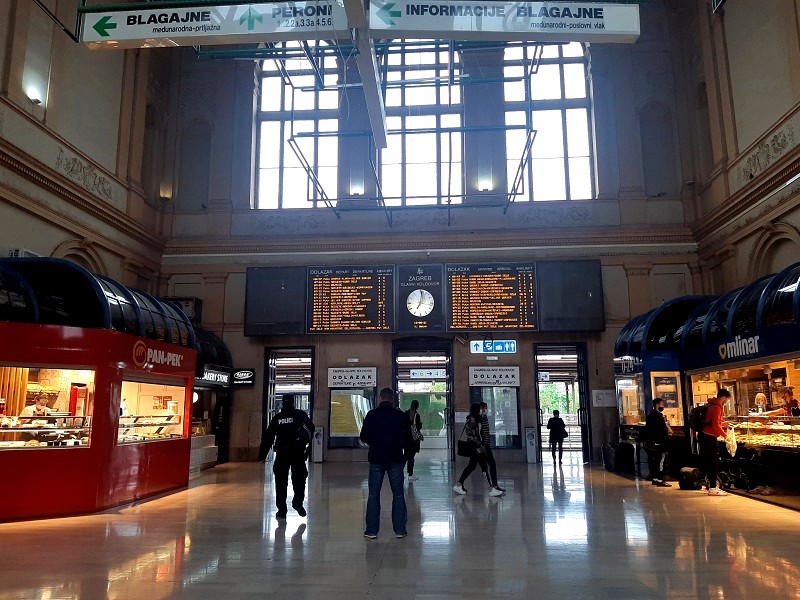

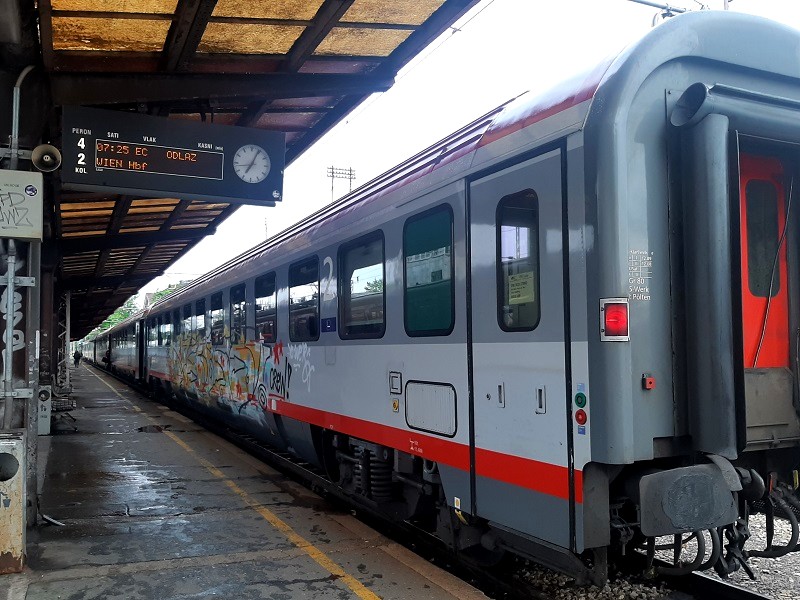
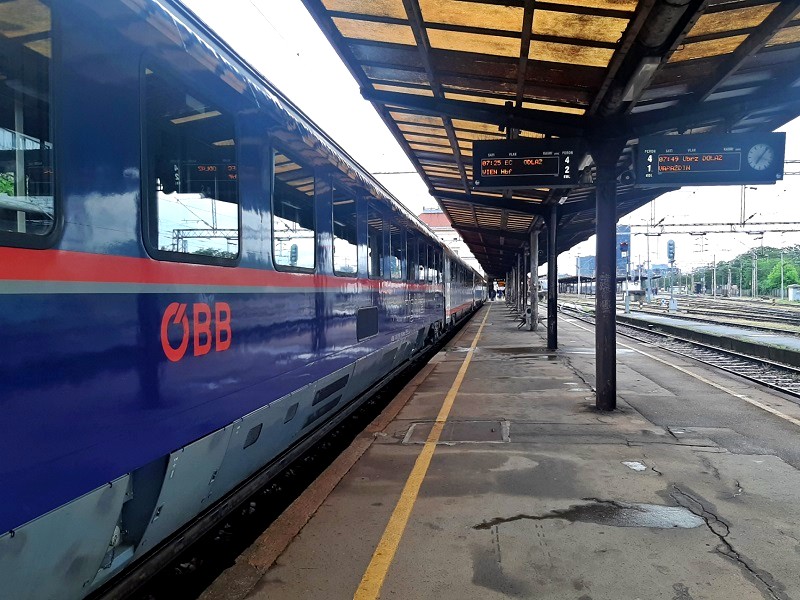
On board EuroCity train “Croatia”
The “Croatia” EuroCity train consists out of first and second class Austrian Railways (OeBB) seating wagons as well as a dining car.
The train has open-plan saloon cars as well as wagons with 6-seat compartment seating in both first and second class.
Seats in the open-plan saloon coaches are arranged in a 2-2 configuration (two abreast at either side of the aisle) in second class while in first class they come in a 1-2 configuration (a solo seat at one side of the aisle, two abreast at the other side).
The compartment coaches have 6-seat compartments in both first and second class.
First class seats are more comfortable and spacious than those in second class and the first class carriages are usually more quiet too in both passenger numbers as well as passenger noise levels.
Seats in both classes have power sockets, although the train is not equipped with WiFi internet.
If you reserve a seat you can usually choose between a seat in the open-plan saloon car or one in the compartment carriages and specify your preference for a window or aisle seat (all pending availability, of course).
Needless to say, you are free to move to another seat during the journey if you find one unoccupied.
You can see which seat is reserved by looking at the reservation panels (underneath the overhead luggage rack in the open-plan saloon cars or outside the compartment door in the six-seat compartment coaches).

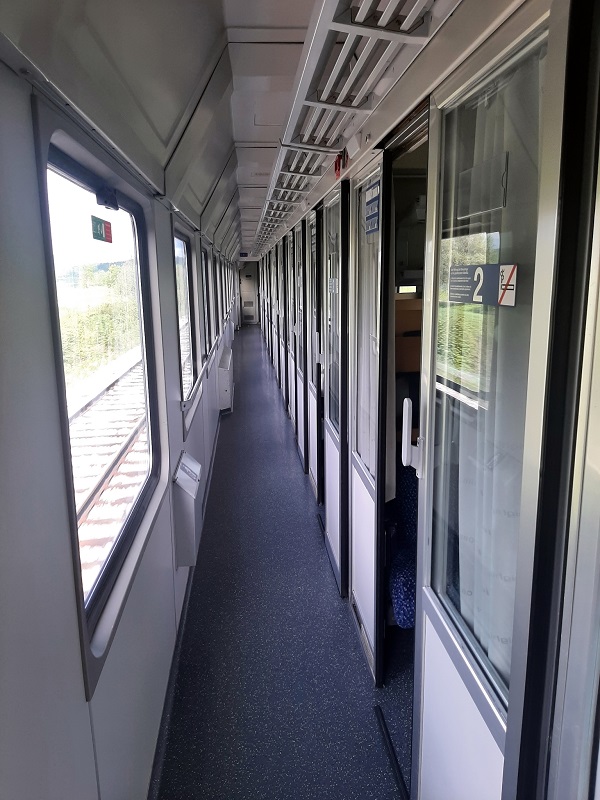
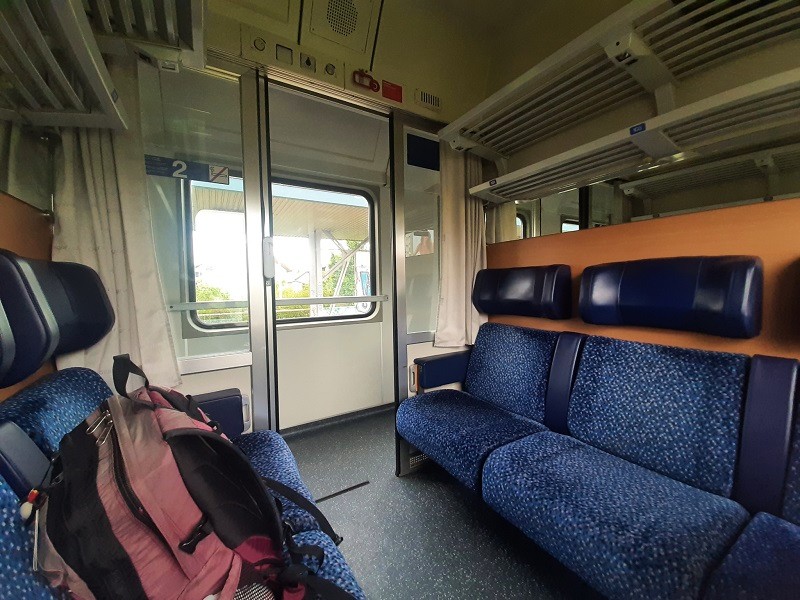
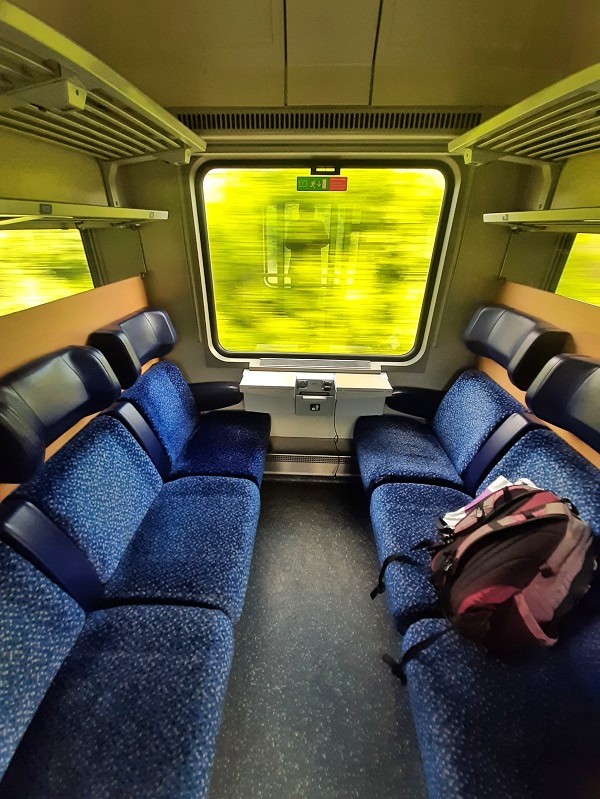


Zagreb departure
My reserved seat was a window seat in one of the six-seat compartments of the Zagreb-Vienna EuroCity train.
Although three other seats were reserved as well in my compartment for the entire ride between Zagreb and Vienna, only one passenger showed up on departure.
My compartment mate turned out to be a friendly Croatian chap who was on his way back to Vienna to work after spending some time back home.
After leaving the Zagreb suburbs, the Croatia EuroCity train heads straight for Dobova, the border station with neighbouring Slovenia.
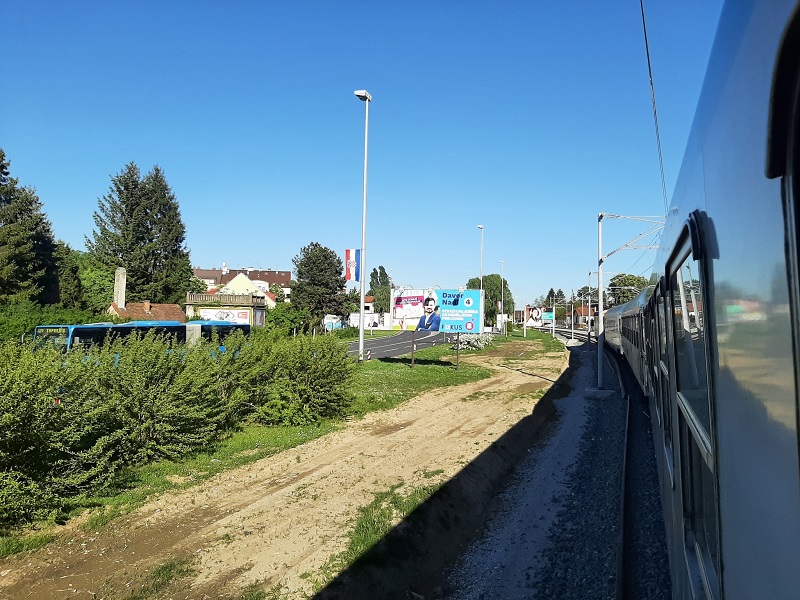
Croatian-Slovenian border
At Dobova, both Croatian and Slovenian border guards will board the train for passport control and customs checks.
Even though both Croatia and Slovenia are EU countries, only Slovenia is part of the border-free Schengen Area.
It is therefore unsurprising that Croatian exit procedures are rather quick but that Slovenian immigration does take a bit longer.
As I was travelling at peak COVID pandemic times (May 2021), the Slovenians were quite thorough as well with checking vaccination certificates and all other relevant travel documentation.
My vaccination certificate was accepted without problem, although my Croatian compartment mate had more problems with documents.
He did not have a vaccination certificate, nor did he have a negative PCR test.
Although technically none of these were required at the time when transiting Slovenia or entering Austria (as long as he would go into self-isolation there and take a test) the Slovenian border guards did not accept his story for some reason.
In the end, the poor guy was kicked out of the train at Dobova and probably put on the first train back into Croatia by the Slovenian border guards.

Along the river
With a delay of 20 minutes, the “Croatia” EuroCity train continued deeper into Slovenia.
Inside Slovenia, this EuroCity train stops at Krsko, Sevnica, Lasko, Celje Poljcane, Pragersko and finally Maribor, the second largest city of the country.
Although I felt sad for my compartment mate being unfairly kicked out of the train, I did now have the space all to myself.
Once across the border in Slovenia, the first bits of beautiful scenery start to appear as the train rides along the Sava River.
The best views are from your left-hand side at this part of the journey.




Zidani Most
As the train approaches the important junction of Zidani Most, the Sava river valley narrows into a gorge.
This is one of the most scenic parts of the entire trip between Zagreb and Vienna and it should not be missed.
Even though I had already travelled this railway line multiple times before I was still glued to the window as the scenery is simply gorgeous.
Just before the train reaches Zidani Most station, the railway line splits in two.
The “Croatia” EuroCity train takes the railway line towards the right, bypassing the station of Zidani Most station and heading north along the Savinja River towards Maribor and the Austrian border.
The railway branching off on the left is the line to Ljubljana.
If you watch through the window on your left-hand side you can see that railway line crossing the bridge over the confluence of the Sava and Savinja rivers as it heads to Zidani Most station, which I think is one of the most beautifully located train stations in all of Europe.


Towards Austria
Having left Zidani Most junction behind, the river gorge widens out again into the Savinja river valley.
Although not as scenic as the ride along the River Sava, it’s still a pleasant journey.
Watch out for Celje Castle on your right-hand side when travelling north towards Austria.
As the “Croatia” EuroCity train crosses the Drava River you will also have a great view over the old town of Maribor on your left-hand side.
Together with the Austrian city of Graz, Maribor is perhaps the most important stop of the “Croatia” EuroCity train on its long route between Zagreb and Vienna.
After Maribor, the train continues towards the Austrian border station of Spielfeld-Straß.

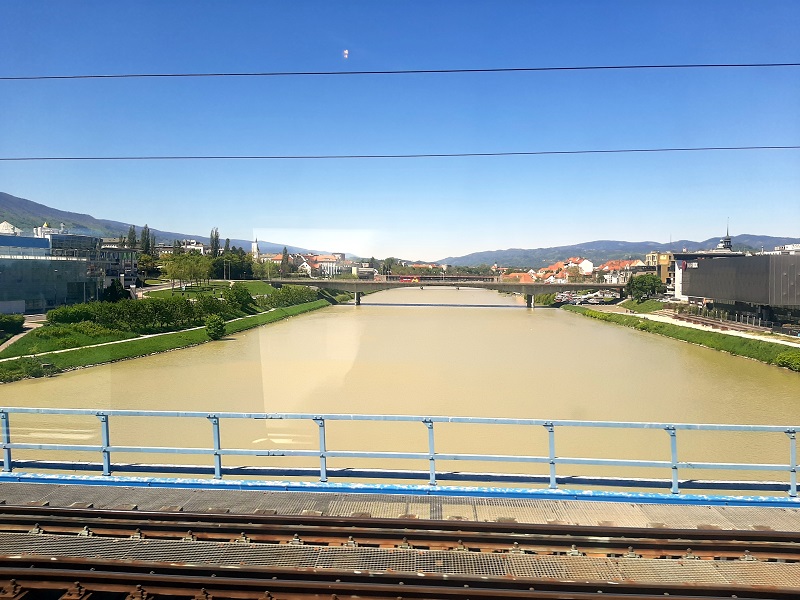
Austrian border
As both Slovenia and Austria are within the Schengen Area, there are normally no passport checks at the Austrian border station of Spielfeld.
However, this time the Austrian border guards did board our train to check passports and COVID documents such as vaccination certificates and negative PCR tests.
Unlike the Croatian-Slovenian border, this went pretty fast fortunately.
As I was just transiting the country and would immediately take the night train from Vienna to Bucharest after arrival, I was exempt from all entry requirements which Austria had at that time.
Our arrival at the Austrian border also meant that the train’s dining car could finally open as Slovenia and Croatia both had COVID regulations forbidding the sale of food and drinks on public transport.
Fortunately, the Austrians were more sane and did allow dining cars to function normally, which meant that I could finally enjoy a glass of Weizen.
Whilst sipping my beer I watched the train continue deeper into Austria, first stopping at Leibnitz before a more lengthy stop in the city of Graz.
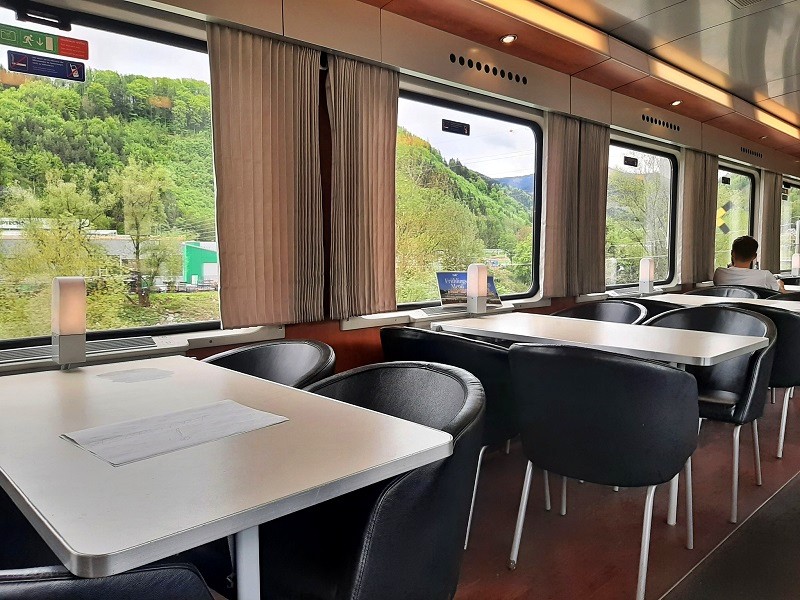


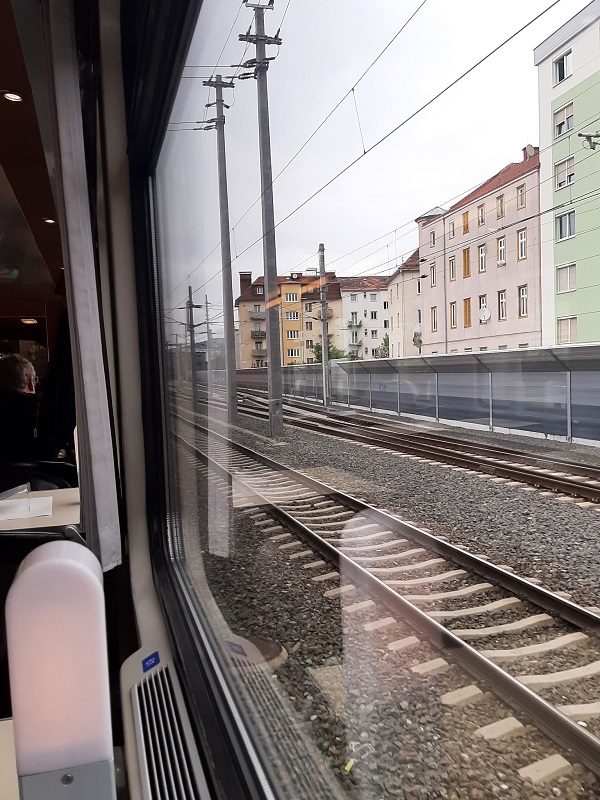

Lunch in the dining car
The great thing about Austrian Railways EuroCity trains like the Zagreb to Vienna “Croatia” service is that they have a dining car available where you can enjoy hot and cold drinks, snacks and even full meals.
When I entered the dining car just before the Austrian border it was empty, although the carriage filled up fast with hungry and thirsty passengers after the stop in Graz.
To start, I ordered a goulash soup, which was tasty.
The Wiener schnitzel (pan-fried breaded veal cutlet) certainly tasted good too, although it was not in the same league as the excellent schnitzel in the Slovenian dining car of the “Emona” EuroCity train.
To wash it all away, I enjoyed a couple of glasses of Austrian red wine.
Of course, I couldn’t resist a dessert so I ordered an yummy ‘apfelstrudel’ (apple strudel) as well.
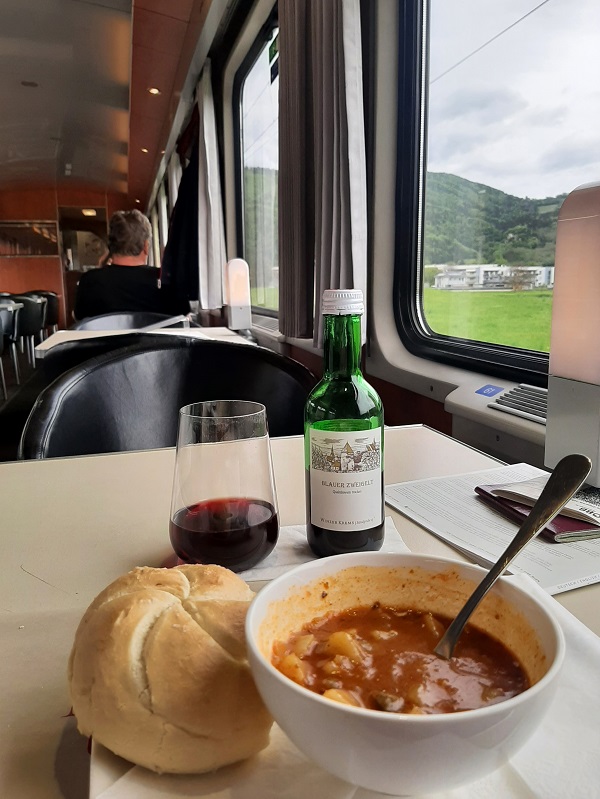

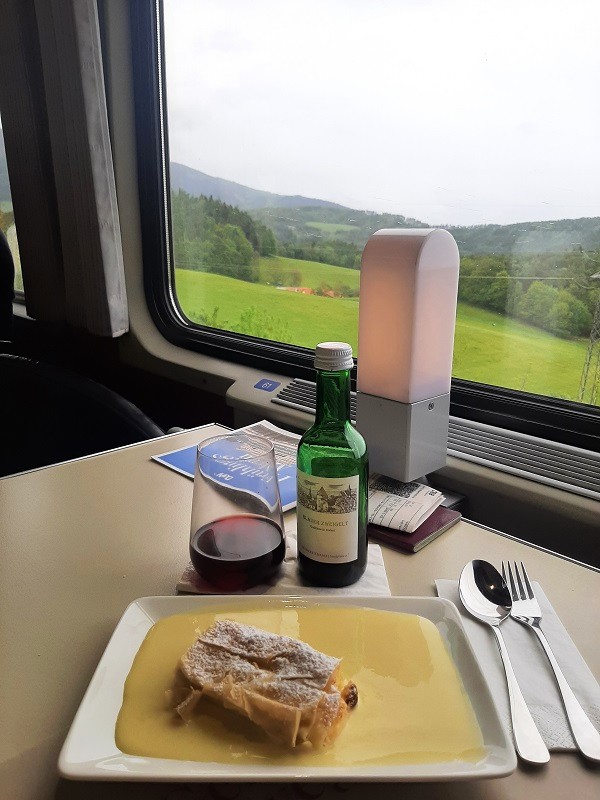
Towards the Semmering
After its stop at Graz, the “Croatia” EuroCity train makes its way towards the Alps, stopping in Styrian towns such as Bruck an der Mur and Kapfenberg.
The scenery now turns more hilly as the train follows the course of the River Mur.
When the train halts at the station of Mürzzuschlag, the famous Semmering Pass is just a short distance away.
Unfortunately, the weather started to get more gloomy as we approached the mountains.



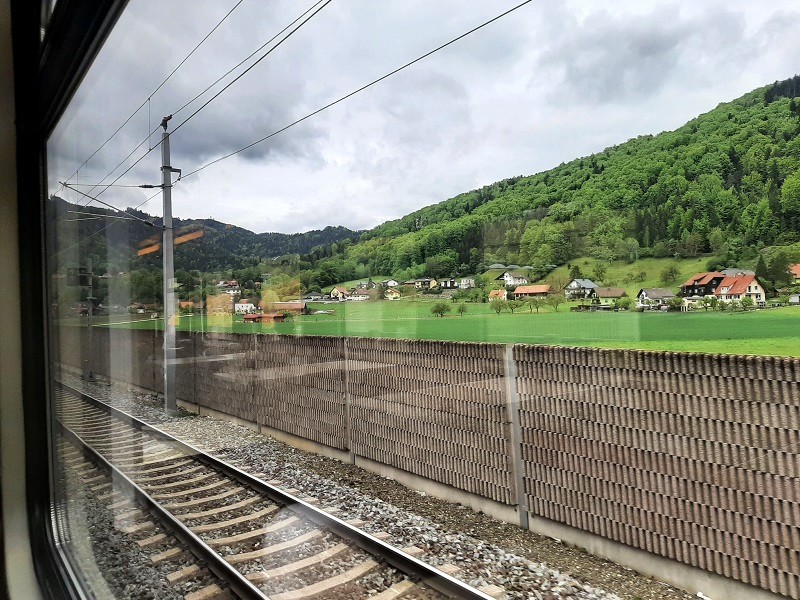




Semmering Railway
The true highlight of the journey between Zagreb and Vienna is the ride over the Semmering Railway between Mürzzuschlag and Gloggnitz.
Completed in 1854, the Semmering was the first mountain railway in Europe.
To cross the Alpine pass, the engineers built 16 viaducts and 14 tunnels on the 41-kilometre-long railway line.
Considering the highly difficult terrain and the year it was built it’s an astonishing feat of engineering and therefore not a surprise at all that the Semmering Railway was put on the UNESCO World Heritage List.
Especially at the moment when the train crosses one of the curved viaducts you can enjoy some fabulous views over the mountain scenery and bits of the winding railway line.
Make sure you sit on the right-hand side of the train for the best views of the Semmering Railway when travelling from Graz to Vienna.
Do however note that long-distance services such as the “Croatia” EuroCity train will likely bypass the most scenic parts of the line when the Semmering Base Tunnel is set to open in 2024.
I therefore certainly enjoyed this opportunity to enjoy the fabulous views of the Semmering from the comfort of the dining car while sipping a glass of Blauer Zweigelt!

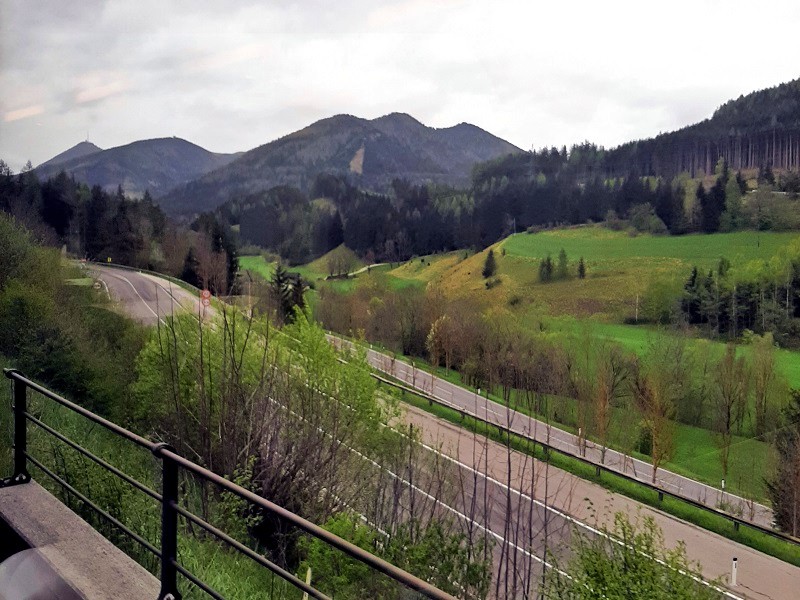




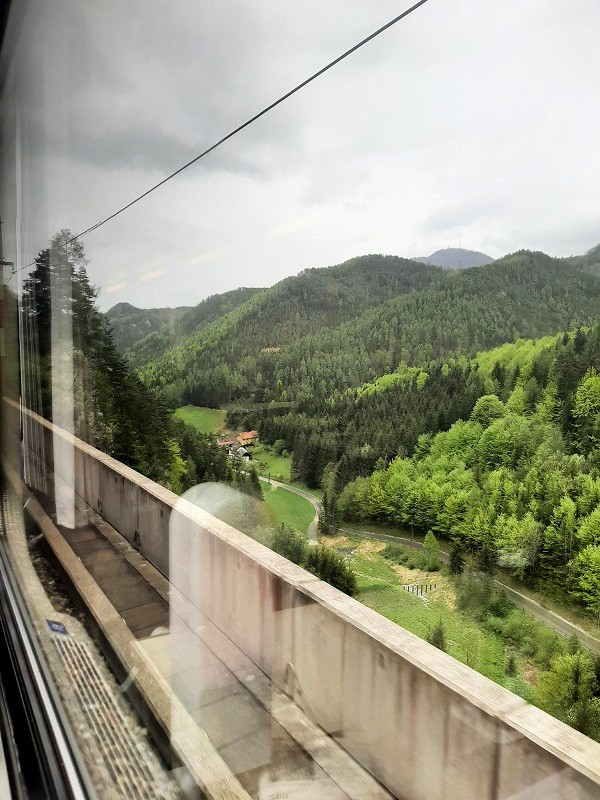
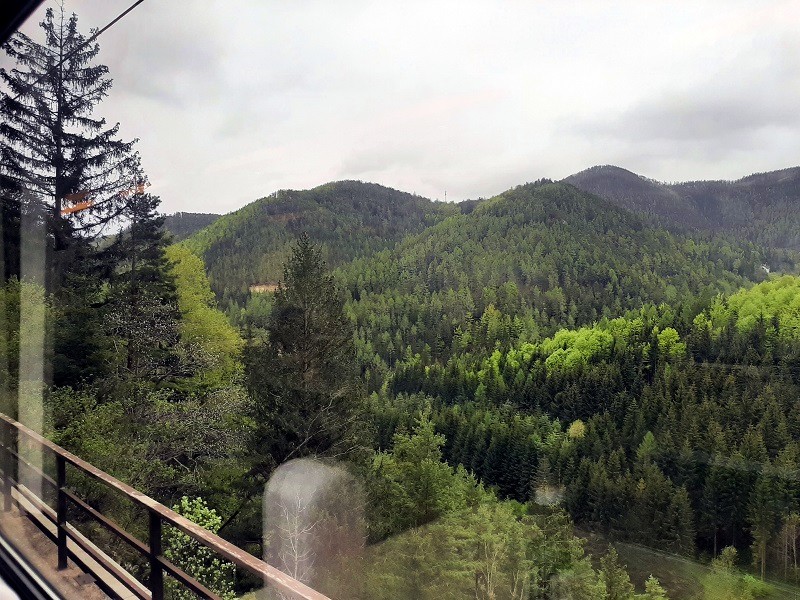

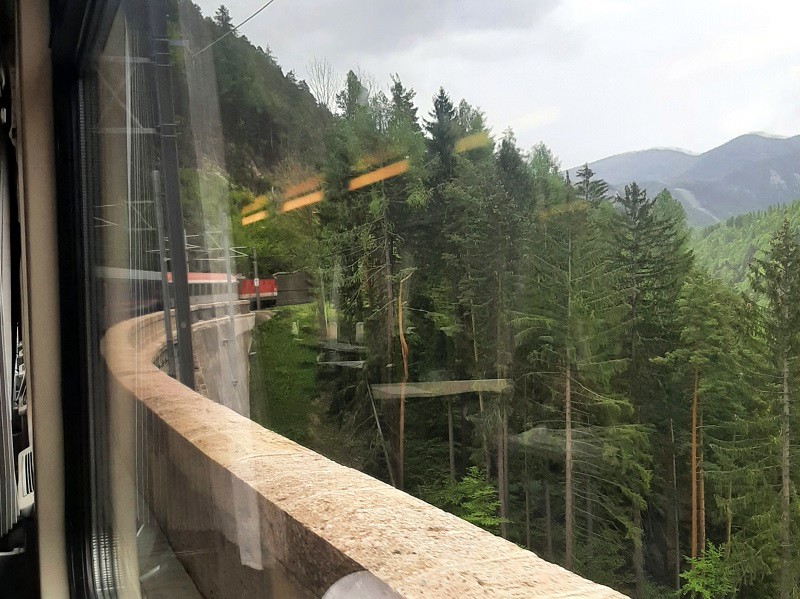



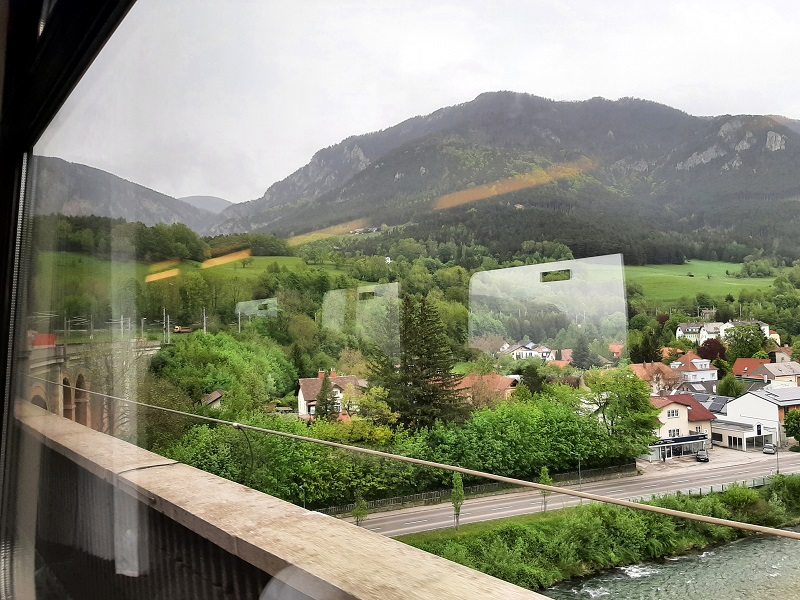
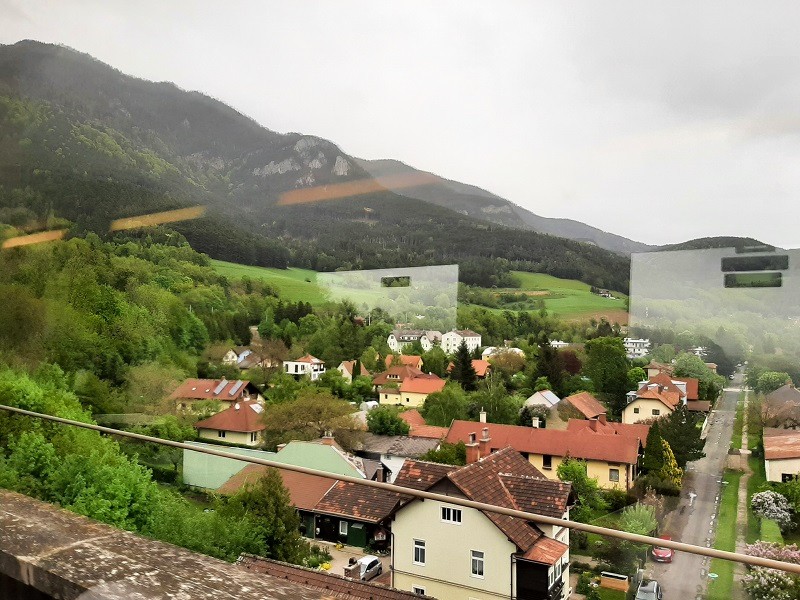

Vienna arrival
Before the EuroCity train “Croatia” arrives at its final stop of Wien Hbf (Vienna Main station) it stops in the city of Wiener Neustadt and the secondary Viennese station of Wien Meidling.
After all the grandeur of the Semmering Railway, the landscape of Lower Austria is a tad more boring to put it lightly.
Because the terrain is mostly flat and the railway infrastructure is good, the train does however pick up speed and therefore covers the stretch rather quickly.
As the dining car was closing, I ordered a takeaway coffee as a last drink before arrival in Vienna.
With a 30-minute delay, the EuroCity train “Croatia” pulled into Vienna’s modern central station.
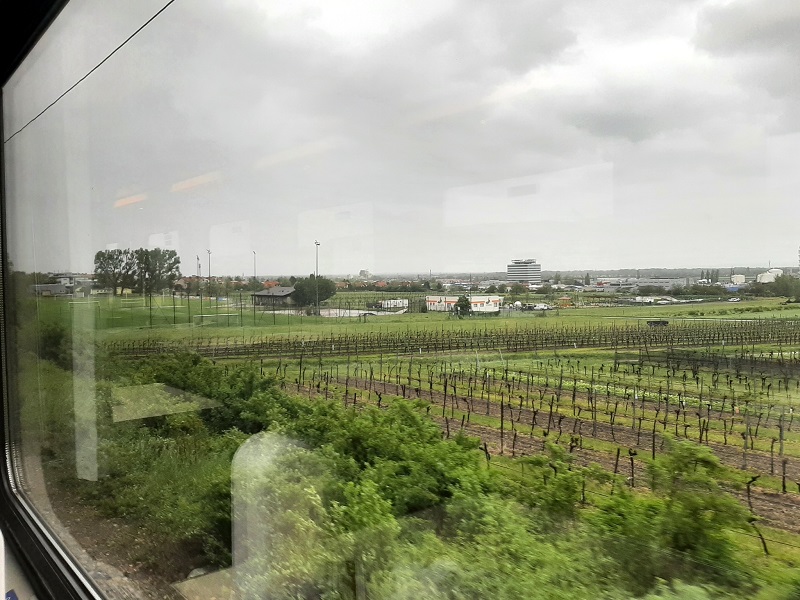




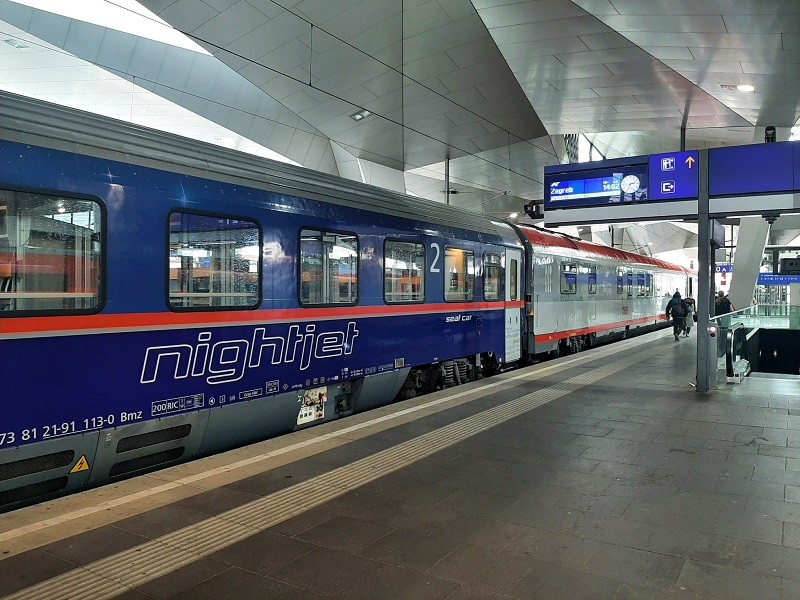


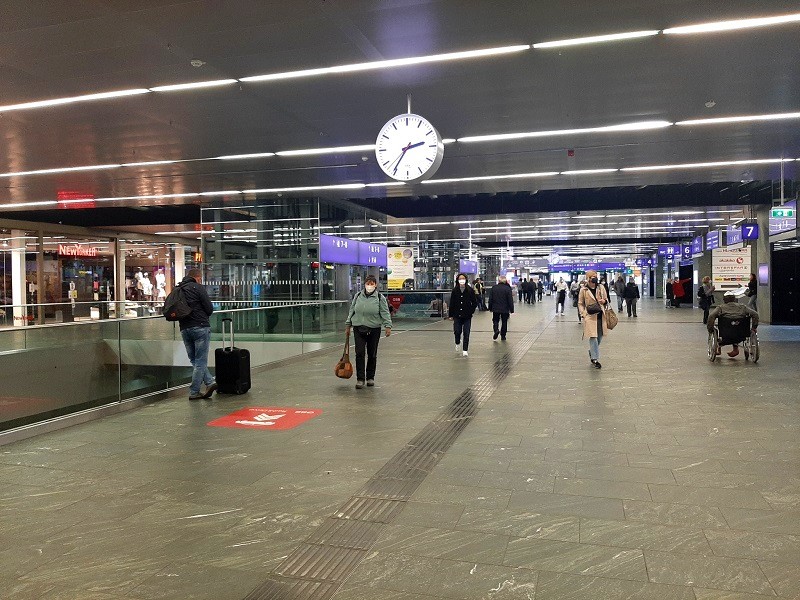
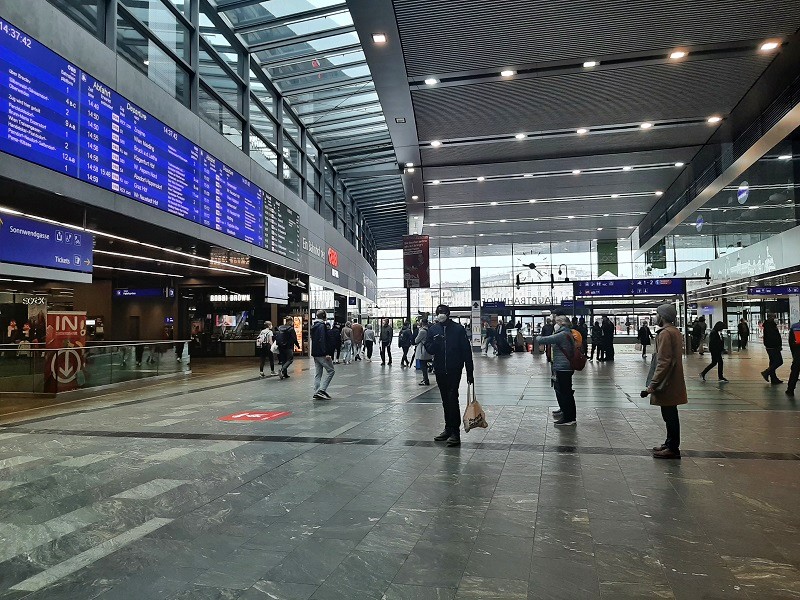


Conclusion
It was a great pleasure to take the EuroCity train “Croatia” along its entire route between Zagreb and Vienna.
The train consists out of comfortable first and second class seating cars and has a dining car where you can get a drink or grab a full meal.
Although flying between Zagreb and Vienna is obviously faster, you would miss out on some fine scenery from the train window.
The EuroCity train “Croatia” takes in the Sava River gorge around Zidani Most in Slovenia as well as the highly scenic Semmering Railway in Austria, making this journey a real treat.
Sit down in your compartment or in the dining car, enjoy a beer or glass of wine, watch the wonderful views pass by from the window and you know why travelling this route by train is such a pleasure.
Trip report index
This article is part of the ‘Across Europe by Train: Interrail in the Age of Corona‘ trip report, which consists of the following chapters:
1. Review: LOT Polish Airlines Economy Class Bucharest to Warsaw (Embraer ERJ-175)
2. Walking Through an Empty Warsaw in Corona Lockdown
3. Review: Four Points by Sheraton Warsaw Mokotow
4. Review: LOT Polish Airlines Economy Class Warsaw to Zurich (Boeing 737 MAX)
5. A Stopover Walk Through the Old Town of Zurich
6. Review: Railjet Train Zurich to Feldkirch
7. An Evening in Friendly Little Feldkirch
8. Review: Nightjet Train Feldkirch to Graz
9. A Short Walk Along the Sights of Graz
10. Review: Emona EuroCity Train Vienna – Ljubljana – Trieste
11. Zidani Most: Europe’s Most Picturesque Train Station
12. Review: Ljubljana to Zagreb by EuroCity Train EC 1211 ‘Sava’
13. Flying With Trade Air on a Let L-410 Turbolet Across Croatia
14. Review: Palace Derossi, Trogir, Croatia
15. A Visit to the Tranquil Island City of Trogir, Croatia
16. Cycling on Ciovo: A Trogir Day Trip by Bike
17. Split: Croatia’s Bustling Seaside City Full of History
18. Review: Croatian Railways ICN Train Split to Zagreb
19. Review: Esplanade Hotel, Zagreb, Croatia
20. Zagreb: A Guide to Croatia’s Underrated Capital City
21. Review: EuroCity Train “Croatia” Zagreb to Vienna (current chapter)
22. Review: Dacia Night Train Vienna to Bucharest


A very thorough review. We will be taking the same train next week –16/12/22
Thank you.